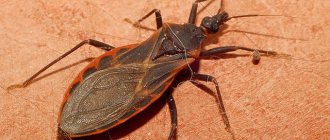The risk of contracting tick-borne encephalitis while in a tick habitat remains throughout the warm period of the year, but the likelihood of getting bitten by an infected tick is much higher in endemic regions. Let's find out which regions of the Russian Federation are endemic for tick-borne encephalitis, and which of them are the most dangerous during the period of tick activity.
An area endemic for tick-borne encephalitis is an area in whose ecosystem the causative agent of tick-borne encephalitis is constantly present, and almost every season there are cases of encephalitis in people bitten by ticks in this region.
The carriers of encephalitis are ixodid ticks. The endemicity of a region is formed as follows: ticks and warm-blooded animals living in this region regularly become infected with the virus from each other and become carriers of the disease. In this case, neither ticks nor animals die from encephalitis, but are only intermediate hosts of the virus.
This virus simply exists in their bodies and is passed on from generation to generation. But if an infected tick bites a person, the person in most cases becomes seriously ill. The tick can also infect farm animals, such as cows. If a person drinks milk from an infected cow, he will also get encephalitis.
Ticks in the Central Federal District (CFD)
The Central Federal District consists of 18 regions (subjects of the Russian Federation), which in turn are divided into districts and settlements. According to the Rospotrebnadzor document, areas of tick-borne encephalitis are considered endemic.
Ivanovo region
3 districts of the Ivanovo region, namely:
- Kineshemsky;
- Ivanovsky;
- Zavolzhsky districts.
Tver region
In the Tver region there are more dangerous areas - 12 out of 37. Encephalitis ticks were identified in the following areas:
- Torzhoksky;
- Oleninsky;
- Krasnokholmsky;
- Rameshkovsky;
- Maksatikhinsky;
- Vyshnevolotsky;
- Kashinsky;
- Nelidovsky;
- Konakovsky;
- West Dvinsky;
- Likhoslavlsky;
- Kalininsky.
Yaroslavl region
In the Yaroslavl region, 18 out of 23 districts are among the endemic tick-borne encephalitis:
- Poshekhonsky;
- Danilovsky;
- Uglichsky;
- Gavrilo-Yamsky;
- Rostovsky;
- Breitovsky;
- Nekouzsky;
- Rybinsky;
- Yaroslavsky;
- Myshkinsky;
- Bolsheselsky;
- Lyubimsky;
- Pervomaisky;
- Nekrasovsky;
- Breitovsky;
- Tutaevsky;
- as well as the cities of Rostov, Yaroslavl and Rybinsk.
Moscow region
In the Moscow region, only 2 out of 52 districts are considered dangerous for tick-borne encephalitis:
Ticks in the Central Federal District (CFD)
- Taldomsky;
- and Dmitrovsky districts.
- As for the Kostroma region, its entire territory is classified as an endemic zone.
Which areas of the Central Federal District are not included in the list of endemic tick-borne encephalitis :
- Belgorod region;
- Bryansk;
- Voronezh;
- Vladimirskaya;
- Kaluzhskaya;
- Lipetskaya;
- Ryazan;
- Orlovskaya;
- Tambovskaya;
- Smolenskaya;
- Tula;
- Moscow city.
Clarification! The status of an endemic area for tick-borne encephalitis is assigned if several cases of infection of residents after a tick bite are detected.
Ticks in the Northwestern Federal District (NWFD)
Ticks in the Northwestern Federal District (NWFD)
The Northwestern Federal District consists of 11 regions. And only two of them are not endemic for tick-borne encephalitis.
These are the Murmansk region and the Nenets Autonomous Okrug. The remaining areas are more or less dangerous. Therefore, residents in these areas should take extra care.
Regions and districts of the Northwestern Federal District that have the status of endemic tick-borne encephalitis.
The territories of the Pskov, Novogorod, Leningrad, Kaliningrad and Vologda regions are among the endemic, that is, potentially dangerous;
Komi Republic
In the Komi Republic, only 8 districts have this status;
- Kortkerossky;
- Syktyvdinsky;
- Ust-Vymsky;
- Koygorodsky;
- Sysolsky;
- Priluzsky;
- Ust-Kulomsky;
- city of Syktyvkar.
Arhangelsk region
The Arkhangelsk region consists of 25 administrative territories. 20 areas are considered endemic. This:
- Plesetsky;
- Shenkursky;
- Vilegodsky;
- Kotlassky;
- Nyandomsky;
- Vinogradovsky;
- Ustyansky;
- Kholmogorsky;
- Onega;
- Velsky;
- Kargopolsky;
- Lensky;
- Seaside;
- Verkhnetoyemsky;
- Pinezhsky;
- Krasnoborsky;
- Konoshsky;
- and the cities of Mirny, Koryazhma and Kotlas.
Republic of Karelia
The Republic of Karelia consists of 18 districts, and 13 of them are classified as endemic areas for tick-borne encephalitis.
- Olonetsky;
- Suoyarvsky;
- Belomorsky;
- Prionezhsky;
- Pryazhinsky;
- Kondopoga;
- Sortovalsky;
- Segezhsky;
- Lahdenpokhsky;
- Medvezhyegorsky;
- Pudozhsky;
- Pitkyaransky;
- and the city of Petrozavodsk along with its surroundings.
Regarding St. Petersburg itself, only 6 out of 18 districts are considered endemic for tick-borne encephalitis. This relatively low figure was achieved thanks to annual sanitary and epidemiological measures that help control the population of ticks infected with encephalitis and other dangerous infections.
Districts of St. Petersburg that are endemic for tick-borne encephalitis:
- Seaside;
- Pushkinsky;
- Kolpinsky;
- Petrodvortsovy;
- Krasnoselsky;
- Resort.
The remaining 18 administrative territories of St. Petersburg are relatively safe.
How does infection occur?
Tick-borne encephalitis is a seasonal disease. For Ixodes Persulcatus, the period of activity is May and June. And Ixodes Ricinus is characterized by two peaks per season - the beginning and end of summer, that is, May, June and August, September.
These are periods of active work on agricultural land, gardens and personal plots. In spring and summer, the movements of tourists relaxing in the lap of nature become more active. Even a walk in an urban area through a park or alley can lead to tick bites. Once on the skin, the arthropod makes a small incision, generously moistening it with saliva, and injects an anesthetic. More than 10 hours may pass from the moment of suction to the appearance of unpleasant sensations.
The incubation period averages 1–2 weeks. In the febrile form, the disease begins acutely and resembles the flu. The victim complains of hyperthermia (high body temperature), painful headaches, nausea, and vomiting.
A complicated course and unfavorable prognosis are characteristic of the meningeal and encephalitic (focal) forms. The viral infection has a toxic effect on the central and peripheral nervous system and is complicated by paralysis of the limbs. In 1–3% of patients, the disease becomes chronic. Mortality figures depend on the strain and range from 2% for the European form to 20% for the Far Eastern form.
Ticks in the North Caucasus and Southern Federal Districts
The entire territory of the North Caucasus Federal District is safe and does not have endemic status. If ticks are found here, they are rare.
And they are usually not infected with any dangerous infections.
Regarding the Southern Federal District, the picture is approximately the same, with the exception of Crimea and the city of Sevastopol.
In Crimea, 9 out of 25 districts have the status of endemic tick-borne encephalitis. This:
- Simferopol;
- Belogorsky;
- Kirovsky;
- Bakhchisarai;
- as well as the cities of Sudak, Alushta, Feodosia, Simferopol and Yalta.
Regarding the city of Sevastopol, its entire territory is considered endemic for tick-borne encephalitis. It is worth considering this information before traveling to Crimea on vacation.
How much higher is the likelihood of infection in an endemic area?
The risk of contracting tick-borne encephalitis in an endemic area is much higher than the average throughout the entire habitat of ixodid ticks. From 2 to 10% of ticks are carriers of the dangerous virus. Despite the measures taken, up to several dozen cases of tick-borne encephalitis are recorded per season, and some cases are fatal.
Ticks in the Volga Federal District (VFD)
The Volga Federal District consists of 14 constituent entities of the Russian Federation. There are both dangerous areas and relatively safe ones from the point of view of tick-borne encephalitis. For example, all 40 districts of the Kirov region are included in the list of endemic tick-borne encephalitis. This applies to both the Udmurt Republic and the Perm Territory. There are also safe areas, including:
- Penza region;
- Saratovskaya;
- The Republic of Mordovia;
- Chuvash Republic.
Ticks infected with encephalitis are not found in these areas.
Which areas and areas are considered endemic.
Nizhny Novgorod Region
The Nizhny Novgorod region consists of 50 administrative territories. According to a document prepared by Roskomnadzor, the following areas are considered endemic for tick-borne encephalitis:
Ticks in the Volga Federal District (VFD)
- Gorodetsky;
- Bogorodsky;
- Borsky;
- Koverninsky;
- Sharangsky;
- Shakhunsky;
- Vetluzhsky;
- Ardatovsky;
- Tonshaevsky;
- Kulebaksky;
- Pochinkovsky;
- Semenovsky;
- Balakhninsky;
- D. Konstantinovsky;
- Sosnovsky;
- Chkalovsky;
- Vorotynsky;
- Kstovsky;
- Pavlovsky;
- Urensky;
- Shatkovsky;
- Arzamas;
- Krasnobakovsky;
- Tonkinese;
- Voskresensky;
- Dineevsky;
- Varnavinsky;
- Vachsky;
- as well as the cities of Novy Novgorod and Dzerzhinsk .
Republic of Bashkortostan
The Republic of Bashkortostan consists of 68 administrative territories. The prevailing number of districts (42 districts) are considered endemic for tick-borne encephalitis:
- Yanaulsky district;
- Abzelilovsky;
- Sharansky;
- Alsheevsky;
- Chimshinsky;
- Askinsky;
- Chekmagushevsky;
- Bakalinsky;
- Fedorovsky;
- Belebeevsky;
- Uchalinsky;
- Belokataysky;
- Ufa;
- Beloretsky;
- Tuymazinsky;
- Birsky;
- Tatyshlinsky;
- Blagoveshchensky;
- Sterlitamak;
- Budziakski;
- Sterlibashevsky;
- Buraevsky;
- Salavatsky;
- Gafuriysky;
- Nurimanovsky;
- Burzyansky;
- Miyakinsky;
- Davlekanovsky;
- Mishkinsky;
- Duvansky;
- Mechetlinsky;
- Ermikeevsky;
- Meleuzovsky;
- Zilairsky;
- Kuyurgazinsky;
- Iglinsky;
- Kugarchinsky;
- Ishimbaysky;
- Krasnokamsky;
- Kaltasinsky;
- Kiginsky;
- and Karaidelsky.
Samara Region
Encephalitis ticks in the Samara region are found in 26 out of 35 districts. Namely:
- Shigonsky district;
- Bezenchuksky;
- Shentalinsky;
- Bogatovsky;
- Chelno-Vershinsky;
- Bolshe-Glushchitsky;
- Syzransky;
- Borsky;
- Stavropol;
- Volzhsky;
- Sergievsky;
- Elkhovsky;
- Privolzhsky;
- Kamyshlinsky;
- Pokhvistnevsky;
- Kinelsky;
- Krasnoyarsk;
- Kinel-Cherkassky;
- Krasnoarmeysky;
- Klyavlinsky;
- Koshkinsky;
- as well as in the cities of Novokuibyshevsk, Samara, Togliatti, Syzran and Zhigulevsky.
Orenburg region
In the Orenburg region, only 7 out of 47 administrative territories contain ticks infected with encephalitis. Endemic areas include:
- Ponomarevsky district;
- Sharlyksky;
- Abdulinsky;
- Sakmarsky;
- Buguruslansky;
- Northern;
- and Orenburg region .
Marie El
In Mari El there are 11 endemic areas for tick-borne encephalitis. These are:
- Sernursky district;
- Volzhsky;
- Orshansky;
- Zvenigovsky;
- Novotoryalsky;
- Kilemarsky;
- Morkinsky;
- Mari-Tureksky;
- Medvedevsky;
- and the cities of Volzhsk and Yoshkar-Ola.
Ulyanovsk region
The Ulyanovsk region, compared to others in the Volga Federal District, is relatively safe from the point of view of ticks carrying encephalitis. Encephalitis ticks can be found only in 5 districts of the Ulyanovsk region. This:
- Sengilevsky district;
- Melekessky;
- Staro-Mainsky;
- Mainsky;
- and Ulyanovsk region.
Republic of Tatarstan
Encephalitis ticks in the Republic of Tatarstan live in 30 administrative territories. These areas are considered endemic:
- Agryzsky district;
- Yutazinsky;
- Aznakaevsky;
- Cheremshansky;
- Aksubaevsky;
- Chisptopolsky;
- Aktanyshsky;
- Tyulyachinsky;
- Alkeevsky;
- Tukaevsky;
- Alekseevsky;
- Spassky;
- Almetyevsky;
- Sabinsky;
- Bavlinsky;
- Nurlatsky;
- Bugulminsky;
- Novosheshminsky;
- Verkhneuslonsky;
- Nizhnekamsk;
- Vysokogorsky;
- Muslyumovsky;
- Elabuga;
- Menzelinsky;
- Zainsky;
- Mendeleevsky;
- Laishevsky;
- Leninogorsk;
- as well as the cities of Kazan and Naberezhnye Chelny .
All of the above-mentioned territories of the Volga Federal District are endemic for tick-borne encephalitis. If you live in one of the above areas, take basic precautions to protect yourself from possible tick bites.
Ticks in the Ural Federal District (UFD)
Ticks in the Ural Federal District (UFD)
The Ural Federal District consists of 6 constituent entities of the Russian Federation. Three areas are endemic for tick-borne encephalitis, namely:
- Tyumen region.
- Sverdlovskaya.
- And Chelyabinsk region.
At the same time, no encephalitis ticks were recorded in the Yamalo-Nenets Autonomous Okrug. This county is not endemic.
Two areas are considered endemic.
Khanty-Mansiysk Autonomous Okrug
19 administrative territories are recognized as endemic areas:
- Sovetsky district;
- Nefteyugansk;
- Nizhnevartovsk;
- October;
- Kondinsky;
- Khanty-Mansiysk;
- Surgutsky;
- as well as the cities of Yugorsk, Urai, Pyt-Yakh, Surgut, Pokachi, Nefteyugansk, Langepas, Nizhnevartovsk, Kogalym, Megion, Nagan and Khanty-Mansiysk.
Kurgan region
In the Kurgan region, 19 out of 26 administrative territories are recognized as endemic areas. Areas that are endemic for tick-borne encephalitis:
- Yurgamyshsky;
- Belozersky;
- Shchuchansky;
- Vargashinsky;
- Shumikhinsky;
- Dalmatovsky;
- Shatrovsky;
- Kargapolsky;
- Shadrinsky;
- Cathay;
- Chastoozersky;
- Ketovsky;
- Mokrousovsky;
- Kurtamyshsky;
- Mishninsky;
- Lebyazhevsky;
- Makushinsky;
- and cities - Shadrinsk and Kurgan .
In these areas, the presence of ticks carrying dangerous strains of encephalitis was detected.
The most dangerous regions of Russia for tick-borne encephalitis
Traditionally, the most dangerous areas for the likelihood of encephalitis are considered to be:
- Siberia;
- Ural;
- Far East.
Here are the main foci of tick-borne encephalitis, but cases of disease are also common in the middle zone, the Volga region and in the north-west of Russia. Endemic areas within all these zones are located unevenly: there are relatively favorable and extremely dangerous areas, delineated by climatic zones or landscape features.
Ticks in the Siberian Federal District (SFO)
The Siberian Federal District consists of 10 constituent entities. These territories are considered the most dangerous not only for tick-borne encephalitis, but also for Lyme disease (borreliosis), turrets and various fevers.
Important! You can find out more about ticks, their habitats and the infections they carry in the article “Tick bite: classification, danger to humans, effective means of protection”
In which areas of Siberia are encephalitis ticks found?
Krasnoyarsk region
Encephalitis ticks were found in 57 districts of the region, among them:
- Shushensky district;
- Achinsky;
- Sharypovsky;
- Balakhtinsky;
- Uyarsky;
- Berezovsky;
- Uzhursky;
- Birilyussky;
- Tyukhtensky;
- Bogotolsky;
- Turukhansky;
- Boguchansky;
- Taseevsky;
- Bolshemurtinsky;
- Sukhobuzimsky;
- Bolsheuluisky;
- Sayan;
- Dzerzhinsky;
- Rybinsky;
- Yeniseisky;
- Pirovsky;
- Emelyanovsky;
- Guerrilla;
- Ermakovsky;
- Novoselovsky;
- Idrinsky;
- Nizhneingashsky;
- Ilansky;
- Nazarovsky;
- Irbeysky;
- Motyginsky;
- Kazachinsky;
- Minusinsky;
- Kansky;
- Mansky;
- Karatuzsky;
- Kuraginsky;
- Kezhemsky;
- Krasnoturansky;
- Kozul districts;
- as well as the cities of Sosnovoborsk, Achinsk, Sharypovo, Bogotol, Nazarovo, Borodino, Minusinsk, Divnogorsk, Lesosibirsk, Yeniseisk, Krasnoyarsk, Kansk ;
- and the villages of Solnechny, Kedrovy, Zheleznogorsk and Zelenogorsk .
Omsk region
In the Omsk region, 16 out of 33 districts pose a potential danger, being endemic for tick-borne encephalitis. Districts:
- Ust-Ishimsky;
- Bolsherechensky;
- Tyukalinsky;
- Bolsheukovsky;
- Tevrizsky;
- Gorkovsky;
- Tarski;
- Znamensky;
- Sedelnikovsky;
- Kolosovsky;
- Sargatsky;
- Krutinsky;
- Omsk;
- Muromtsevsky;
- Nizhneomsky;
- and the city of Omsk.
Irkutsk region
In the Irkutsk region, 30 out of 36 districts are endemic for tick-borne encephalitis. This:
- Angarsk;
- Ekhirit-Bulagatsky;
- Brotherly;
- Osinsky;
- Balagansky;
- Nukutsky;
- Zhigalovsky;
- Bokhansky;
- Zalarinsky;
- Bayandaevsky;
- Ziminsky;
- Alarsky;
- Irkutsk;
- Shelekhovsky;
- Kazachinsky;
- Chunsky;
- Kachugsky;
- Cheremkhovsky;
- Kuytunsky;
- Usolsky;
- Nizhneudinsky;
- Ust-Udinsky;
- Olkhonsky;
- Ust-Ilimsky;
- Slyudyansky;
- Tulunsky;
- Taishet districts;
- as well as the cities of Sayansk , Irkutsk and Bratsk .
Novosibirsk region
In the Novosibirsk region, 23 districts are in the endemic zone for tick-borne encephalitis. Namely:
- Barabinsky district;
- Chulymsky;
- Bolotninsky;
- Cherepanovsky;
- Vengerovsky;
- Chanovsky;
- Iskitimsky;
- Ust-Tarsky;
- Kargatsky;
- Toguchinsky;
- Kolyvansky;
- Suzunsky;
- Kochenevsky;
- Northern;
- Krasnozersky;
- Ordynsky;
- Kyshtovsky;
- Maslyaninsky;
- Novosibirsk;
- Moshkovsky;
- as well as the cities of Ob, Berdsk and Novosibirsk.
The Republic of Khakassia
The Republic of Khakassia also suffers from ticks infected with encephalitis. In this Republic, 10 out of 13 areas are considered endemic:
Ticks in the Siberian Federal District (SFO)
- Askizsky district;
- Ordzhonikidzevsky;
- Beysky;
- Shirinsky;
- Bogradsky;
- Ust-Abakansky;
- Tashtypsky;
- as well as the cities of Sorsk, Abaza and Sayanogorsk.
Tyva Republic
In the Republic of Tyva, 13 subjects are recognized as endemic areas for tick-borne encephalitis, including:
- Dzun-Khimchinsky district;
- Kaa-Khemsky;
- Tere-Kholsky;
- Kyzylsky;
- Chedi-Kholsky;
- Pius-Khemsky;
- Chaa-Kholsky;
- Sut-Kholsky;
- Ulug-Khemsky;
- Tandinsky;
- Todzhinsky;
- Tes-Khemsky;
- as well as the city of Kyzyl .
Some regions of the Siberian Federal District have full-territorial status as endemic for tick-borne encephalitis without division into regions. These territories include:
- Tomsk region . The entire area is considered endemic.
- Kemerovo region . The situation is similar.
- Altai Territory and the Altai Republic . Ticks infected with encephalitis are found throughout the area.
Important! In the Siberian Federal District, all regions in one way or another belong to endemic territories.
Ticks in the Far Eastern Federal District (FEFD)
The Far Eastern Federal District is divided into 11 regions (subjects of the Russian Federation). Let us immediately clarify that some areas of the Far Eastern Federal District are completely free from tick-borne encephalitis, for example:
- Magadan Region;
- Kamchatka Krai;
- The Republic of Sakha (Yakutia);
- Chukotka Autonomous Okrug.
There are no ticks that spread encephalitis in these areas.
At the same time, in the Far Eastern Federal District there are areas whose territories fully fall under the definition of endemic. There are only three of them:
- The Republic of Buryatia . Encephalitis ticks are found throughout the area.
- Jewish Autonomous Region.
- Primorsky Krai.
Next, we present a list of districts of the Far Eastern Federal District that are included in the list of endemic ones:
Khabarovsk region
In the Khabarovsk Territory, 16 out of 19 territorial entities are recognized as endemic. Which:
- Khabarovsk district and the city of Khabarovsk itself;
- Ulchsky district;
- Amursky;
- Solar;
- Bikinsky;
- Sovetsko-Gavanskiy;
- Vaninsky;
- Nikolaevsky;
- Verkhnebureinsky;
- Nanaisky;
- Vyazemsky;
- Komsomol;
- them. Lazo;
- them. Osipenko;
- also the city of Komsomolsk on Amur.
Amur region
In the Amur region, 16 districts are endemic for tick-borne encephalitis:
- Arkharinsky district;
- Szymanowski;
- Bureysky;
- Tyndinsky;
- Zeysky;
- Skovorodinsky;
- Magdagachinsky;
- Selemdzhinsky;
- Mazanovsky;
- Svobodnensky;
- and Romnensky district;
- The endemic cities also include the cities of Shimanovsk, Zeya, Tynda, Uglegorsk, Svobodny and ZATO .
Sakhalin region
In the Sakhalin region, 15 out of 18 districts are endemic. This is more than 80% of the region. What areas are these:
- Alexandrovsk-Sakhalinsky;
- Kurilsky;
- Anivsky;
- Kholmsky;
- Dolinsky;
- Uglegorsky;
- Korsakovsky;
- Tymovsky;
- Makarovsky;
- Tomarinsky;
- Nevelsky;
- Smirnykhovsky;
- Poronaisky;
- Nogliki;
- and the city of Yuzhno-Sakhalinsk .
Transbaikal region
In the Trans-Baikal Territory, ticks infected with encephalitis are also found. 24 out of 32 districts of the region are listed as endemic. This:
- Akshinsky district:
- Mogotuysky;
- Alexandrovo-Zavodsky;
- Dulgurginsky;
- Baleyskiy;
- Aginsky;
- Borzinsky;
- Shilkinsky;
- Gazimuro-Zavodsky;
- Shelopuginsky;
- Kalgansky;
- Chitinsky;
- Karymsky;
- Chernyshevsky;
- Krasnochikoisky;
- Khiloksky;
- Mogochinsky;
- Uletovsky;
- Nerchinsky;
- Tungochensky;
- Olovyanninsky;
- Skretensky;
- Petrovsk-Zabaikalsky;
- also the city of Chita.
Let us remind you that the presented list of districts, regions and districts recognized as endemic for tick-borne encephalitis will be relevant in 2022, and most likely in 2023-2024. Some adjustments are possible due to climate change, migration of ticks to the northern regions of the Russian Federation or the intensity of sanitary and epidemiological measures carried out by government services. But only within a small margin of error.
Post Views: 1,522
Specifics of endemic areas
The localization area of the natural focus of the virus is constant, but its boundaries change from time to time, and within the range itself, areas free from tick vectors are sometimes formed.
This is partly due to climatic phenomena, due to which the number of ticks either rises or falls, for example - too hot and dry summers reduce the number of parasites, and a mild, warm spring helps to increase their numbers. The law of cyclicity also works: a sharp increase in the number of ticks is inevitably followed by a decline, so in different years these parasites become either more or less numerous.
Ticks concentrate mainly in the forest zone, preferring shady, cool corners with tall, dense grass. But some forest areas are so isolated that ticks are not able to penetrate their territory. An example is the mountainous Caucasus. There are forests and living conditions suitable for ticks, but there are no encephalitis ticks here, since they have not reached this region.










